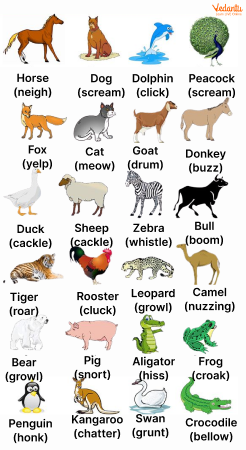




Kids Awareness to Animal Sounds
Growing up, a kid should be aware of the sounds which they hear on a daily basis. From an early age, they should be introduced to the sounds which are created by the animals. Starting off, they should know who barks and who mews.
As parents and teachers, we want our kids to develop in an all-around manner so that the inclusion of animal sounds in their awareness system should be a part of their learning process. Thus, we introduce this article “Animals Sound in English” where the kids can learn the various sounds of animals.
Know the Sounds of Each of These Animals

Animal Sounds
Note:➤ Don't Miss Out: Get Your Free NEET Rank Predictor Instantly!
Let us study the interesting sounds made by the animals. Given below are the names of the animals and their sounds. Read it aloud.
Make Sentences with the Sound of Animals
Meow: The cat was crying “Meow Meow! Let me out!”
Barking: The dogs were barking in the deserted streets.
Growled: The tigress growled at the visitors at the zoo.
Hiss: The snakes on the tree made hiss sounds.
Sing: Do whales actually sing when they communicate?
Howling: The wolves were howling all night long over the hills.
Screaming: The vultures were screaming in the sky.
Roar: The roar of the Royal Bengal Tiger is heard in this forest.
Squeaking: What is the squeaking sound coming underneath the chair? Is it a Rat!
Cooed: The pigeons cooed on the ceiling at my grandma’s place.
Bleating: The goats were bleating loud at night.
Mooing: The cows were mooing while grazing the fields.
It was indeed a long list of the sounds of animals! And, we know the different types of sounds in English and also know many animals with the help of the chart studied above. It will not only help us to increase kids’ vocabulary but also introduce different sounds.
Animals That Produce No Sound
Some animal species do not produce any sound, despite the fact that the majority of animal species can, either vocally or mechanically. Moving animals will always generate sounds with their bodies, but this is unconscious sound production. The animal frequently makes mechanical sounds on purpose.
Snails, slugs, and worms do not actively produce sound as a means of communication. The only sound they are known to make is when they move and their bodies rub against the ground.
Jellyfish are another example of an aquatic animal that does not make noise on purpose. While swimming, they can produce sound waves with their tentacles or bell, although this is unconscious sound production. Jellyfish cannot communicate because they lack a brain capable of generating the complex patterns of behaviour required to generate sound.
Summary
In the English language, the animal sound or onomatopoeia help in understanding and enhancing pronunciation. Generally, animals make two types of sounds vocal and mechanical. Different animals produce different sounds. Even though the majority of animal species can, either vocally or mechanically, some do not create any sound. Moving creatures will constantly make sounds with their bodies, although this is unconscious. Intentionally, the animal frequently makes mechanical sounds.
Snails, jellyfish slugs, and worms are some examples of animals that do not produce sound to communicate.
FAQs on Animals Sound for Kids
1. Suggest some good books for the kids to learn the animal sounds.
Some good books for kids to learn the animal sounds are as follows:
Noisy Baby Animals
Baby Farm Animals
Sound Book
The Little Book of Safari Animal Sounds
Noisy Farm.
2. Define animals for kids.
Animals are living things like plants and human beings. They also require food and water to live. Unlike plants, animals do not cook their own food. They feed on other plants and animals. Animals are sensitive to their environment and can move around easily like human beings.
3. How many sounds can a dog make?
Dogs may know 100 words, but they can only vocalize about 15 different sounds. Cats may only understand 25 to 35 words, but they can make about 100 different vocalizations.









